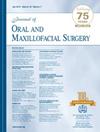Does Liposomal Bupivacaine Reduce Postoperative Pain Following Third Molar Extractions? A Double-Blinded Randomized Controlled Trial
IF 2.3
3区 医学
Q2 DENTISTRY, ORAL SURGERY & MEDICINE
引用次数: 0
Abstract
Background
Liposomal bupivacaine (LB) is a long-lasting local anesthetic providing analgesia for several days. The current literature examining the efficacy of LB in pain management following third molar extractions remains unclear.
Purpose
The purpose of this study was to compare postoperative pain management between LB and standard bupivacaine (SB) in mandibular third molar extractions.
Study Design
A double-blinded randomized controlled trial of subjects undergoing bilateral mandibular third molar extractions at our institution from 2022 to 2024 was conducted using a split-mouth study design. Subjects were excluded if they received additional mandibular teeth extractions, were unable to complete the questionnaire, or had medical contraindications.
Predictor Variable
The predictor variable was postsurgical local anesthetic agent, and the sides of mouth were randomly assigned to LB or SB.
Main Outcome Variable(s)
Primary outcome was postoperative pain on a 10-point numerical rating scale (NRS), and the mean cumulative pain rating via area under the curve (AUC) analysis. Secondary outcomes were adverse events and ibuprofen or acetaminophen consumption.
Covariates
Demographics, procedure time, preoperative and perioperative local anesthetics used, and procedural difficulty coded as nonsurgical or surgical were collected.
Analyses
We used mixed-effects models to compare the NRS scores during each time period and paired t-tests to compare AUC values. Statistical tests included 95% CIs with alpha = 0.05.
Results
The study sample included 72 subjects (mean age 25.8, SD: 9). Pain was lower in the LB versus SB group on surgery day (NRS difference −0.75; P = .002) until the morning of postoperative day 2 (−0.68, P = .003). When limiting the analysis to bilateral surgical extractions, it was statistically significant until the morning of postoperative day 3 (−0.61, P = .02). AUC analysis showed cumulative pain reduction for the LB group in comparison to the SB group through all 4 postoperative days for the overall cohort (average AUC0-96 difference 93.5, P = .005), with a similar effect for bilateral surgical extractions (101.88, P = .006).
Conclusion
LB modestly reduces pain following third molar extractions, with this difference more pronounced following surgical extractions. This suggests that LB may be more beneficial in complex extractions and greater pain-inducing surgeries.
布比卡因脂质体是否能减轻第三磨牙拔牙术后疼痛?一项双盲随机对照试验。
背景:布比卡因脂质体(LB)是一种持久的局部麻醉剂,可提供数天的镇痛作用。目前的文献研究LB在第三磨牙拔牙后疼痛管理的功效仍不清楚。目的:本研究的目的是比较LB和标准布比卡因(SB)在下颌第三磨牙拔牙术后的疼痛处理。研究设计:采用裂口研究设计,对2022 - 2024年在我院接受双侧下颌第三磨牙拔除的受试者进行双盲随机对照试验。如果受试者接受了额外的下颌拔牙,无法完成问卷调查,或有医疗禁忌症,则排除受试者。预测变量:预测变量为术后局麻药,口腔两侧随机分为LB或sb。主要结果变量:主要结果为术后10分数值评定量表(NRS)疼痛,并通过曲线下面积(AUC)分析平均累积疼痛评分。次要结局是不良事件和布洛芬或对乙酰氨基酚的摄入。协变量:统计数据、手术时间、术前和围手术期使用的局麻药、非手术或手术难度。分析:我们使用混合效应模型来比较每个时间段的NRS评分,并使用配对t检验来比较AUC值。统计检验为95% ci, α = 0.05。结果:研究样本包括72名受试者(平均年龄25.8岁,SD: 9)。手术当天LB组疼痛较SB组更低(NRS差-0.75;P = 0.002)至术后第2天上午(-0.68,P = 0.003)。当将分析限制在双侧手术摘除时,直到术后第3天早上,这一差异均具有统计学意义(-0.61,P = 0.02)。AUC分析显示,在整个队列中,LB组与SB组相比,术后4天的累积疼痛减轻(平均AUC0-96差93.5,P = 0.005),双侧手术拔管的效果相似(101.88,P = 0.006)。结论:LB适度减轻第三磨牙拔除后的疼痛,这种差异在手术拔除后更为明显。这表明LB可能更有利于复杂的拔牙和更大的疼痛诱导手术。
本文章由计算机程序翻译,如有差异,请以英文原文为准。
求助全文
约1分钟内获得全文
求助全文
来源期刊

Journal of Oral and Maxillofacial Surgery
医学-牙科与口腔外科
CiteScore
4.00
自引率
5.30%
发文量
0
审稿时长
41 days
期刊介绍:
This monthly journal offers comprehensive coverage of new techniques, important developments and innovative ideas in oral and maxillofacial surgery. Practice-applicable articles help develop the methods used to handle dentoalveolar surgery, facial injuries and deformities, TMJ disorders, oral cancer, jaw reconstruction, anesthesia and analgesia. The journal also includes specifics on new instruments and diagnostic equipment and modern therapeutic drugs and devices. Journal of Oral and Maxillofacial Surgery is recommended for first or priority subscription by the Dental Section of the Medical Library Association.
 求助内容:
求助内容: 应助结果提醒方式:
应助结果提醒方式:


